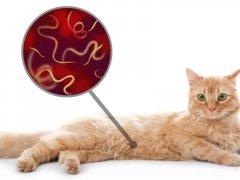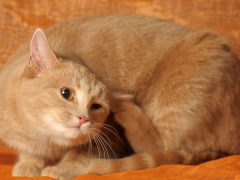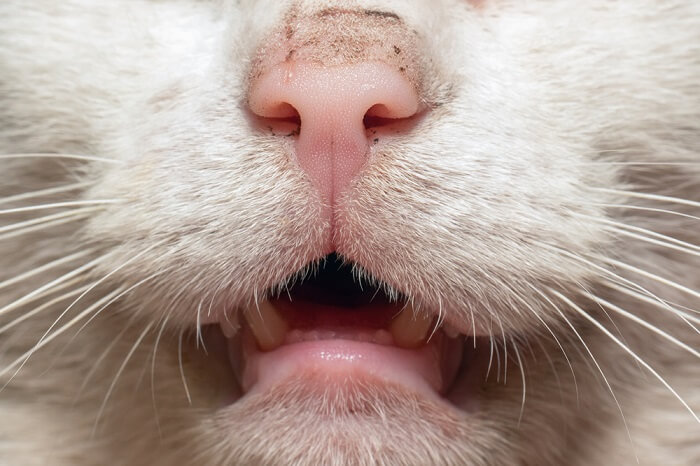
If your cat suddenly begins refusing food and acting uncomfortable around the mouth, there can be several possible causes for this change. In most cases, these signs are caused by treatable dental disease.
In some cases, however, oral pain and reluctance to eat can be caused by an oral tumor. Finding, diagnosing, and treating oral tumors will require partnering with your cat’s veterinarian.
What Is Mouth Cancer in Cats (Feline Oral Squamous Cell Carcinoma)?
Oral cancer accounts for approximately 10% of feline cancer cases and is the third most common site of cancer in cats. Oral cancer leads to the formation of harmful swellings or other lesions within the oral cavity, along the gums, palate (roof the mouth), or within the throat. Squamous cell carcinoma is the most common oral cancer in cats.
Causes of Mouth Cancer in Cats
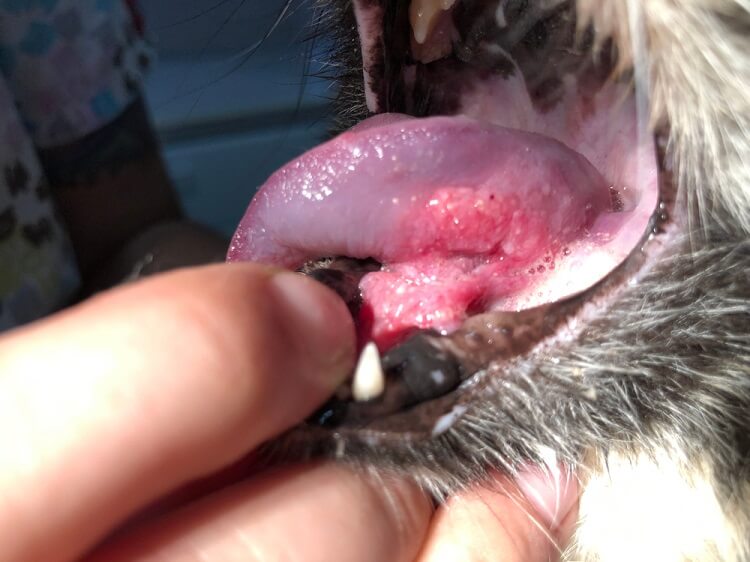
The most common type of oral cancer is squamous cell carcinoma. These represent about 70% of oral tumors in cats.
There are several different types of tumors that can develop in the mouth of a cat. Not all of these tumors are cancerous. Oral masses in cats may be caused by inflammation, infection, or even trauma.
The most common oral cancer in the cat, by far, is squamous cell carcinoma. Approximately 70% of oral tumors in cats are squamous cell carcinomas.
These tumors grow from the lining of the oral cavity, including the gums, tongue, palate, and tonsils. Squamous cell carcinomas are a significant medical problem, because they tend to be locally invasive. Although they rarely metastasize (spread distantly), they often invade the underlying law bones (mandible and maxilla), making complete removal difficult.
Other common causes of oral tumors in cats are fibrosarcomas, osteosarcomas, and odontogenic tumors. Fibrosarcomas arise from the connective tissues within the mouth, often from the jaw bones. Osteosarcomas arise solely from bony tissues, such as the jaw bones. Odontogenic tumors arise from the tissues making up the teeth.
No one knows why some cats develop oral tumors. It is suspected that environmental contaminants, such as cigarette smoke and chemicals found in flea collars, may play a role; however, this has not been proven.
Symptoms of Mouth Cancer
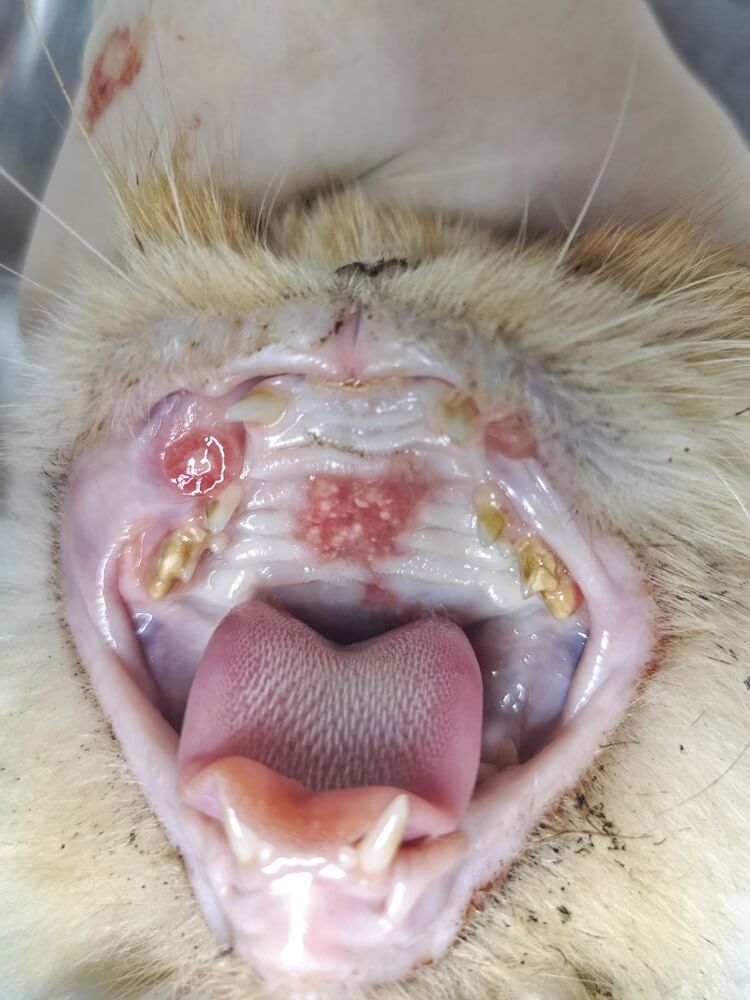
While some mouth cancers are visible, other symptoms can indicate mouth cancer, including bad breath and difficulty eating.
Oral tumors are painful, especially during eating. The first sign of an oral tumor is often a reluctance to eat, accompanied by weight loss. Some cats may act painful when chewing, but in many cases, owners attribute the decrease in appetite to nausea, a need to change the food, or other factors. Cats don’t always show the obvious signs of pain that you would expect, such as pawing at their mouth or acting uncomfortable.
In many cases, growing oral tumors begin to bleed. You may notice that your cat is drooling thick, ropey, blood-tinged saliva. You may also notice small drops of blood saliva around your cat’s food and water bowl, on your cat’s bed, or in other places your cat likes to rest. Your cat may have blood on his or her front paws, from attempting to groom away the bloody saliva from the mouth.
As oral tumors continue to grow, you may notice that your cat has bad breath or halitosis. Your cat’s body may also begin to smell unpleasant, as the saliva is spread across the body with grooming.
It’s important to note that all of these symptoms can also be associated with dental disease. Gum inflammation and dental infections can also lead to difficulty eating, oral bleeding, and foul breath. The only way to distinguish dental disease from an oral tumor is a thorough veterinary workup.
Diagnosis of Mouth Cancer in Cats
Oral tumors can be found in one of two ways. Tumors are often found early, during routine veterinary care. This is the ideal scenario because is more effective when tumors are small. In other cases, however, oral tumors are not detected until the mass is causing significant clinical signs and negatively affecting the cat’s quality of life.
The first step in diagnosing an oral tumor is a thorough physical examination, including an oral exam.
Your veterinarian may be able to get a brief look in the mouth while your cat is awake, but a thorough examination requires sedation or general anesthesia.
In most cases, your veterinarian will recommend general anesthesia, because this will not only allow an examination of the mouth, but also allow your veterinarian to address issues that may be found during that examination (whether they are masses or diseased teeth that require extraction).
Before anesthesia, your veterinarian will perform pre-anesthetic bloodwork. This bloodwork allows your veterinarian to look for underlying diseases that might affect your cat’s anesthesia.
Based on the results of the bloodwork, your veterinarian will develop a detailed treatment plan for your cat. Your cat will receive a combination of injectable anesthetic drugs and inhalant anesthetics, delivered via a breathing tube.
Once your cat is anesthetized, your veterinarian can perform a thorough oral exam, looking for oral tumors or any other abnormalities.
Any time a mass is found in the mouth, even if it is found during a routine dental cleaning, the mass should be biopsied. If the mass is small, excision can be performed at the time of biopsy. If the tumor size is larger, however, oral masses often cannot be completely removed in a single surgery.
Instead, your veterinarian will remove just a small section of the mass for the pathologist to examine and then plan further treatment based on the results of this biopsy.
Biopsy results are typically available approximately one week after surgery.
Your veterinarian will call you with these results and discuss further recommended treatments.
If your cat is diagnosed with an oral squamous cell carcinoma, next steps might include tests to look for metastasis, such as performing fine needle aspirates of your cat’s lymph nodes, radiographs (x-rays), and computed tomography (a CT scan) to assess the bony involvement of your cat’s mass.
Depending on the results of these staging tests, your veterinarian will likely refer you to the oncology department of your local veterinary referral hospital.
Mouth Cancer Treatment and Prognosis
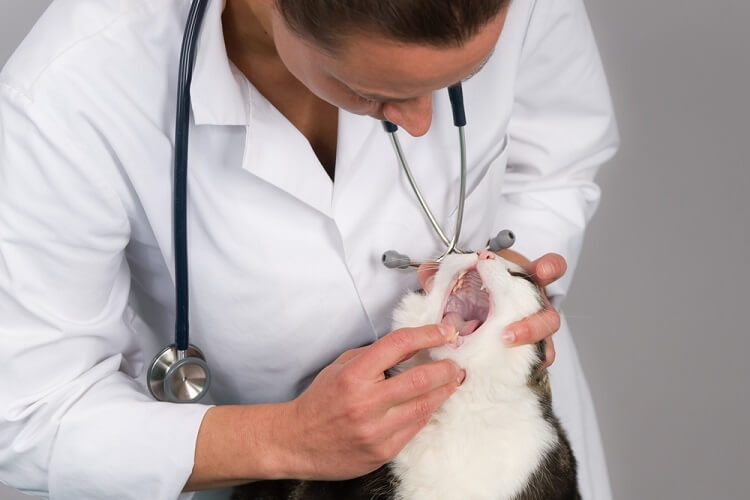
The prognosis for a cat with mouth cancer depends on the type of tumor involved and how advanced it is at the time of diagnosis.
The treatment and prognosis of oral cancer in cats is dependent on two factors: the type of tumor involved and how advanced the tumor is at the time of diagnosis.
Oral squamous cell carcinoma generally is associated with a poor prognosis, regardless of treatment. According to North Carolina State University, cats with oral squamous cell carcinoma survive an average of two to four months with treatments such as surgical removal, radiation therapy, and chemotherapy.
Less than 10% of cats with oral squamous cell carcinoma survive to one year. In general, cats in which the tumor is diagnosed and treated earlier are expected to have better outcomes than cats whose cancer is diagnosed at a later stage.
Other oral tumors, such as fibrosarcoma, osteosarcoma, and odontogenic tumors, are associated with longer anticipated survival times than squamous cell carcinoma. The first step in treating these tumors is typically surgery, which may be followed by radiation and/or chemotherapy.
In some cases, palliative radiation may be used to keep a cat comfortable and extend his or her lifespan, even if the cancer cannot be cured.
Conclusion
If your cat is showing signs of an oral tumor, prompt diagnosis and treatment is essential. While the prognosis for squamous cell carcinoma is not good, other oral tumors can exist and earlier diagnosis will mean that you have a greater likelihood of successful treatment.
